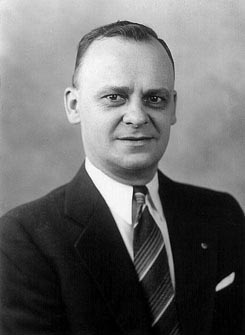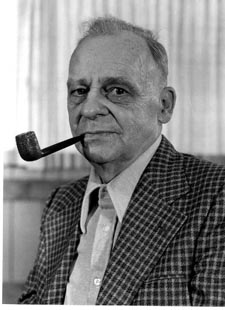National Cambridge Collectors, Inc.
A non-profit 501(c)(3) organization.

Henry Hellmers -- The Genius Behind the Glass Colors of Cambridge
by Les Hansen
Issue No. 350 - June 2002
When you think of colors of Cambridge glass, which ones come to mind? Probably the very vibrant colors, which are most popular and most sought by collectors of Cambridge glass. Let's see, those colors probably would include: Carmen, Royal Blue, Amethyst, Forest Green, Heatherbloom, and Crown Tuscan. All of these colors were introduced by the Cambridge Glass Company during 1931 and 1932. These six colors share something else in common. They were all developed by Henry Hellmers, a glass chemist who was employed by the Cambridge Glass Company from 1930 to 1932.
 |
|---|
| Henry Helmers at 48 years of age in 1945 |
Mr. Hellmers had a long and distinguished career with American glass companies from the time he graduated from the University of Michigan as a chemical engineer in 1921 until his retirement in 1962. He was employed by Akro Agate from 1921 to 1930, briefly by the Westite Company in 1930, by the Cambridge Glass Company from 1930 to 1932, again by Akro Agate from 1932 to 1935, by Aladdin Industries from 1935 to 1942, by Lancaster Lens Company from 1942 to 1946, by Owens-Corning Fiberglass from 1946 to 1949, briefly by Glass Fibers Company in 1949, and finally by Pittsburgh-Corning from 1949 until his retirement 13 years later.
Most notably, Henry Hellmers had a profound effect on colored glass produced by many of the major manufacturers of American-made elegant glassware during the '20s, '30s, and '40s. Besides working on a full-time basis with the previously mentioned companies, he worked on a contract basis and consulted with Heisey, Fostoria, Econony (Morgantown), and Erickson, just to name a few glass companies. He was responsible for perfecting the formulas of some of the most desirable colors produced by many of these companies. Also, he was a master at tweaking formulas to make glass that had the color, clarity, and practical workability that was desired by glass manufacturers.
Hellmers kept track of the glass formulas (his and others) for glass in a "batch" book. At the time of his retirement, this batch book contained 2,373 different formulas for glass. Of these formulas, 544 were for clear crystal; all of the others were for colored glass.
J.W. (Bill) Courter is the Bright Knight of the Aladdin Knights, which is the collector group for items produced by Aladdin Industries. The primary product of this company was their famous Aladdin lamp made in many different colors of glass. Aladdin also produced glass items other than lamps. I have had the pleasure of becoming acquainted with Bill Courter and his wife, Treva, and have spent time with them in their home. Bill is in the process of publishing Henry T. Hellmers' Batch Book of Glass Formulae, and he will provide a copy of the book to the NCC museum. I have had personal inspection of the Hellmers' batch book, and there is little doubt that the book should provide additional insight into the colored glass produced by the Cambridge Glass Company.
 |
|---|
| Hellmers in Retirement, October 13, 1973 |
Bill Courter communicated with Hellmers from 1972 until near the time of Hellmers' death in 1978. Because of Hellmers' impact on Aladdin, Courter visited Hellmers almost annually at the Hellmers' home in Port Allegany, PA, from 1972 to 1978. Fortunately, Willard Kolb asked Courter to be the featured speaker at the 1994 convention of NCC to review the impact of Henry Hellmers on glassmaking in general and the Cambridge Glass Company specifically. That invitation allowed NCC members to become aware of the impact of Henry Hellmers.
The life contributions of Hellmers to the American glass industry has been well reviewed by Bill Courter in Aladdin Electric Lamps, which was privately published by J.W. (Bill) Courter in 1987. This book is widely available and can be obtained directly from the author at 3935 Kelley Rd., Kevil, KY 42053. I have pulled some information, which follows, from that reference.
Hellmers frequently commented on the excellent quality of glass made by Cambridge. Cambridge glass was referred to as "pot glass," which means that it was made in smaller batches under closely controlled conditions compared to "tank glass," which was used by other manufacturers such as Aladdin. Hellmers noted that at the time he was employed by Cambridge, the production emphasis was on tableware (plates, cups, saucers, etc.) rather than decorative items. Hellmers altered numerous formulas for glass colors made by Cambridge (Ebony, Peach Blo, Emerald, Willow Blue, Amber) to make the glass heat resistant, so that hot foods or drinks could be served using these glass items. Of greater importance to collectors, he created wonderful new colors, too.
According to Hellmers, the rumor that Cambridge made some lamps for Aladdin was untrue. Alacite of Aladdin was similar to, but different than, another pink opal glass developed earlier by Hellmers - Crown Tuscan of Cambridge. Crown Tuscan was a pot glass, and Alacite was a tank glass.
Furthermore, Hellmers claimed to have developed both Heatherbloom for Cambridge and Alexandrite for Heisey (similar, but different formulas) using neodymium, a very expensive glass ingredient that causes glass to change in color from pink to blue depending on the source of light. Hellmers was particularly proud of the first commercial selenium ruby glass produced by Cambridge - Carmen - but, sorry folks, there appears to be no truth to the rumor that Carmen contains gold as an ingredient. According to Hellmers, the first Carmen items produced by Cambridge were #1066 stemware.
He changed jobs often. Maybe he felt the need for new challenges and new surroundings; but more than likely, Hellmers' talent was valued by many in the American glassmaking industry, so he simply received financial offers that he could not refuse. Because of his frequent change of employment, Hellmers required his family to move often. The family included wife, Mary, and daughter, Ann. During their retirement, Mary commented that she had moved 19 times since marrying Henry.
Henry Hellmers passed away in 1978 at the age of 80. After his passing, Hellmers' widow and daughter presented the Hellmers batch book of glass formulas to Bill Courter. Mary Hellmers passed away in 1981. Unfortunately, their sole descendant, daughter Ann, passed away shortly thereafter at the age of 58 in 1982. No living descendants of Henry Hellmers remain.
Of the 2,373 glass formulas in Hellmers' batch book, at least 165 are clearly labeled as formulas of the Cambridge Glass Company. Some of the Cambridge formulas are no doubt experimental and developmental colors; however, many of the formulas represent long-term production colors and others are probably "improvements" over earlier formulas for popular selling colors produced by Cambridge. They certainly do not all represent unique colors that were marketed to the public.
During his time at Cambridge, Hellmers acquired the formulas of all the major glass colors produced by Cambridge prior to his arrival in 1930, because those formulas and their sources are in the batch book. The color names, the notations by Hellmers, and the formulas for Cambridge colors in the batch book will be reviewed in the following article.